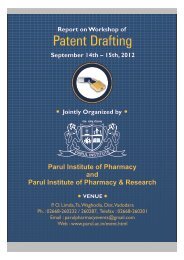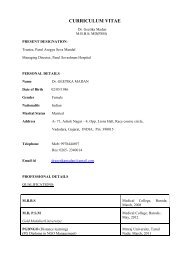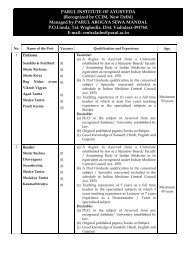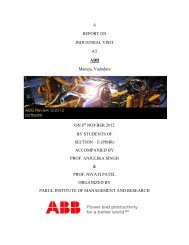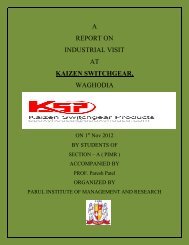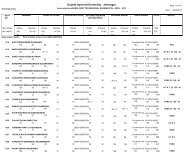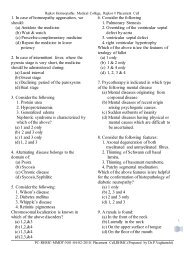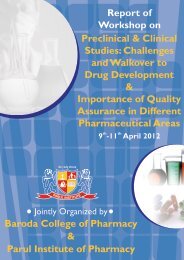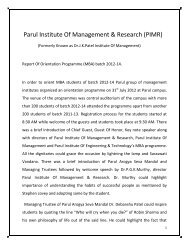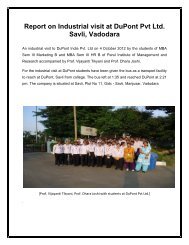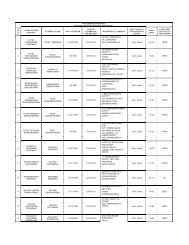4th BHMS Syllabus - Parul Group of Institutes
4th BHMS Syllabus - Parul Group of Institutes
4th BHMS Syllabus - Parul Group of Institutes
Create successful ePaper yourself
Turn your PDF publications into a flip-book with our unique Google optimized e-Paper software.
RAJKOT HOMOEOPATHIC MEDICAL COLLEGE<br />
Accredited Grade B by NAAC<br />
ISO 9001 : 2000 Certified<br />
Homoeopathy (Degree Course)<br />
4 th B.H.M.S.<br />
Homoeopathy (Degree Course) Regulation,1983<br />
Notified in the Official Gazette <strong>of</strong> Government <strong>of</strong><br />
India, New Delhi, the 2<strong>4th</strong> September, 2003 and<br />
implemented from the commencement <strong>of</strong> the<br />
academic session (2003-2004).<br />
Gondal Road, B/H Jainath Petrol Pump, Rajkot- 360002 (Gujarat)<br />
Ph No. 0281-2361372 Fax No.:0281-2373210<br />
E-Mail: rhmc_rajkot@yahoo.com
CONTENTS<br />
Sr.No. Page<br />
No.<br />
01. Preface<br />
02. Personal Detail<br />
03. About Institution<br />
04. Vision and Mission<br />
05. Quality Policy<br />
06. Departments[Map]<br />
07. List <strong>of</strong> Subjects with relevant Detail<br />
(1) Practice <strong>of</strong> Medicine<br />
a) <strong>Syllabus</strong> with Workload<br />
b) Exam pattern according to CCH with marking system<br />
c) Paper style according to Saurashtra University<br />
(2) Case taking & Repertory<br />
a) <strong>Syllabus</strong> with Workload<br />
b) Exam pattern according to CCH with marking system<br />
c) Paper style according to Saurashtra University<br />
(3) Materia Medica<br />
a) <strong>Syllabus</strong> with Workload<br />
b) Exam pattern according to CCH with marking system<br />
c) Paper style according to Saurashtra University<br />
(4) Organon <strong>of</strong> Medicine and Psychology<br />
a) <strong>Syllabus</strong> with Workload<br />
b) Exam pattern according to CCH with marking system<br />
c) Paper style according to Saurashtra University<br />
(5) Community Medicine<br />
a) <strong>Syllabus</strong> with Workload<br />
b) Exam pattern according to CCH with marking system<br />
c) Paper style according to Saurashtra University<br />
08. General guidelines for admission to Examination and scheme <strong>of</strong> examination.<br />
09. Awards in exam
Preface<br />
Life is a constant learning process, after learning & imbibing the knowledge one<br />
can focus him/her to enhance it for growth and development. In this respect, it was found that<br />
students <strong>of</strong> <strong>BHMS</strong> (UG Course) are getting confused to understand the <strong>Syllabus</strong>, Examination<br />
pattern, Gradation as well as Eligibility criteria <strong>of</strong> getting admission in subsequent year as the<br />
existing syllabus is compilation <strong>of</strong> all the four years <strong>of</strong> <strong>BHMS</strong>. The rules and regulation has been<br />
kept in different places. Therefore, the Apex body <strong>of</strong> institution decided to compile the syllabus in<br />
systematize manner. I feel proud to get this opportunity to compile the syllabus and rules and<br />
regulation concern to each year separately for easy reference <strong>of</strong> the students. This is a sincere<br />
effort to simplify the syllabus.<br />
I am obliged to our beloved Managing Trustee Dr.J.K.Patel who is our inspiration<br />
for innovation. I am thankful to Dr.B.P.Panda, Principal and the Chairman <strong>of</strong> Apex Body to provide<br />
this opportunity to me. I extend my thanks to Dr. Amar Sheth, Dr.Prabhat Vaghamshi, Dr.Dharti<br />
Padariya (Faculty Member) and Mr.Kaushik Rathod (Office Staff) for their wholehearted support to<br />
complete this task.<br />
I hope this year wise academic syllabus will be helpful to the students.<br />
Dr. Mitesh Jani<br />
Pr<strong>of</strong>essor<br />
Rajkot Homeopathic Medical College
Personal Details<br />
Name __________________________________________________<br />
Roll No. _____________________ Class ___________________<br />
Admission Year_________________________________________<br />
Address ________________________________________________<br />
_______________________________________________________<br />
Pin code ______________________ Ph. No. _________________<br />
E-Mail __________________________________________________<br />
Driving License No. _______________________________________<br />
Blood <strong>Group</strong> _____________________________________________<br />
IN CASE OF ILLNESS OR ACCIDENT, INFORM<br />
Name ___________________________________________________<br />
Address _________________________________________________<br />
________________________________________________________<br />
___________________________ Pin code _____________________<br />
Phone No. __________________ Mobile No. __________________
About Institution<br />
Rajkot Homoeopathic Medical College is a Leading & reputed Homoeopathic<br />
College <strong>of</strong> Saurashtra region established since 1997. College is recognized by Central<br />
Council <strong>of</strong> Homoeopathy, New Delhi and permanently affiliated to Saurashtra<br />
University, Rajkot. Also it is recognized by Government <strong>of</strong> Gujarat and Government <strong>of</strong><br />
India. Institution is accredited B Grade by NAAC (National Assessment and Accreditation<br />
Council). It is the second institution in Gujarat and fourth in India to own such credit.<br />
Also owns certificate <strong>of</strong> ISO 9001: 2000.<br />
Since establishment the institution has produced quality doctors, who are<br />
working successfully in the field as a private practitioner, as a Medical Officers in<br />
reputed and local hospitals <strong>of</strong> the state, in the 108 emergency medical service <strong>of</strong> Gujarat<br />
Government, Government P.H.C. / C.H.C., as an Honorary Physician in the medical<br />
charitable trust and industries <strong>of</strong> their area, as a faculty in various Homoeopathic<br />
colleges <strong>of</strong> Gujarat and other State <strong>of</strong> India. We are proud that our products have<br />
gained reputation, name and fame in the field due to the quality <strong>of</strong> work they have<br />
done.<br />
E-Mail: rhmc_rajkot@yahoo.com<br />
Web Site: http://www.parul.ac.in
Vision_____________________________________<br />
To establish a ‘Gurukulam Par Excellence’ by making „quality‟ the defining element <strong>of</strong><br />
education.<br />
Mission____________________________________<br />
To transform the student in a way that will bring a new value system in their<br />
thought process, create and innovate newer things for the benefit <strong>of</strong> society as a<br />
whole.<br />
The changes sought are:<br />
From Qualification to Education<br />
What “I can get” to what “I can give”<br />
“External Evaluation” to “Self Evaluation”<br />
“I can‟t” to “I can”<br />
“I” to “We”
1 Liver and Biliary Tract Diseases<br />
2 Hematological Diseases.<br />
3 Cardiovascular system Diseases<br />
4 Kidneys & Urinary Tracts - Diseases<br />
5 Water and Electrolytes balance - Diseases<br />
PRACTICE OF MEDICINE<br />
<strong>Syllabus</strong><br />
6 Connective Tissue Disorders. Bones and Joints Disorders<br />
7 Skin Diseases<br />
8 CNS & peripheral nervous system - Mental Diseases<br />
9 Acute Emergencies including poisonings<br />
10 Pediatrics.<br />
The above in these terms will require a follow us <strong>of</strong> strong and emphatic training on Homoeopathic Therapeutics for the same.<br />
It will be conducted in IV (fourth) <strong>BHMS</strong> at the end <strong>of</strong> 3 years <strong>of</strong> course <strong>of</strong> study in Theoretical and Practical aspects <strong>of</strong><br />
Medicine,<br />
Eligibility for examination shall include submission <strong>of</strong> 10 complete case histories. 5 each being Prepared in III and IV <strong>BHMS</strong>.<br />
PRACTICAL AND CLINICAL EXAMINATION<br />
The examination procedure will include one case, to be prepared, and presented to the examiner, The examiners will put stress<br />
on<br />
1 Comprehensive case Taking.<br />
2 Bedside procedure Investigations for diagnosis<br />
3 Principles <strong>of</strong> management<br />
1) Knowledge <strong>of</strong> clinical/Medicine/Surgery.<br />
GENERAL GUIDENCE : THERAPEUTICS<br />
2) Appreciation <strong>of</strong> Natural disease its evolution in the light <strong>of</strong> Theory <strong>of</strong> chronic miasm. Thus correlation with Organon<br />
Philosophy.<br />
3) Applied Materia Medica and Repertory:<br />
Comprehending drug picture from the evolutionary angle - Boger's approach towards Materia Medica and its application for<br />
the study <strong>of</strong> various clinical patterns <strong>of</strong> Natural disease.<br />
Correlation with MATERIA MEDICA and with REPERTORY.
Workload<br />
Practice Of Medicine & Homeopathic<br />
Therapeutics<br />
Subjects Theoretical Lecture Practical/clinical/tutorial classes<br />
PAPER 1: As per syllabus <strong>of</strong> II & III <strong>BHMS</strong><br />
100}<br />
50} 150<br />
Exam pattern according to CCH<br />
PAPER 2: As per the syllabus <strong>of</strong> IV <strong>BHMS</strong>. Homoeopathic Therapeutics<br />
PAPER 3: Homoeopathy Therapeutics<br />
200 - One term <strong>of</strong> 4 months In OPD & IPD in<br />
different Medical wards/ Dept.<br />
Examination in Practice <strong>of</strong> Medicine including Pediatrics, Psychiatry and Dermatology shall consist <strong>of</strong> three<br />
theory papers and one bedside practical examination. One theory paper shall be exclusively on<br />
Homoeopathic therapeutics. The Practical examination shall consist <strong>of</strong> clinical examination and oral. In the<br />
clinical examination the students shall be examined on his skill on the nosological and therapeutic<br />
diagnosis, through clinical examination, X-ray and other common diagnostic techniques and detailed case<br />
takings on long and short cases. The case reports <strong>of</strong> the students carried out during the course shall also<br />
be considered for the oral examination.<br />
Marking system<br />
Subject Written Practical(including oral) Total<br />
Full<br />
Marks<br />
Pass<br />
Marks<br />
Full Marks Pass Marks<br />
Full<br />
Marks<br />
Pass<br />
Marks<br />
Practice <strong>of</strong> Medicine 300 150 200 100 500 250<br />
Notes:<br />
Paper style according to Saurashtra University<br />
1. Each paper consists <strong>of</strong> 100 Marks which is divided in to two sections.<br />
2. Each section will carry 50 Marks.<br />
3. In each section there shall be 2 (two) long question each <strong>of</strong> 15 Marks.<br />
4. One long question may be divided in to two Bit questions <strong>of</strong> Equal Marks.<br />
5. There shall be one Short Note Question which will carry 20 Marks <strong>of</strong> equally distributed Marks in each<br />
short Question.
HOMOEOPATHIC REPERTORY<br />
<strong>Syllabus</strong><br />
REPERTORY<br />
Repertorization is not the end but means to arrive to the simillimum together with Materia Medica based on sound<br />
principles <strong>of</strong> Philosophy. Homoeopathic Materia Medica is an encyclopedia <strong>of</strong> Symptoms. No mind can memorize all<br />
the symptoms or all the drugs with their characteristic gradation. The repertory is an index and catalogue <strong>of</strong> the<br />
symptoms <strong>of</strong> the Materia Medica, nearly arranged in a practical form and also indicating the relative gradation <strong>of</strong><br />
drugs, and it greatly facilitates quick selection <strong>of</strong> indicated remedy. It is impossible to practice Homoeopathy without<br />
the aid <strong>of</strong> repertories.<br />
Each repertory has been compiled on distinct philosophical base, which determines its structure. In order to exploit<br />
full advantage <strong>of</strong> each repertory it is important to grasp thoroughly its conceptual base and construction. This will<br />
help student to learn scope, limitations and adaptability <strong>of</strong> the repertory.<br />
Case taking<br />
Difficulties <strong>of</strong> taking a chronic case. Recording <strong>of</strong> cases and usefulness <strong>of</strong> record keeping.<br />
Totality <strong>of</strong> symptoms, prescribing symptoms; uncommon peculiar and characteristic symptoms. Analysis <strong>of</strong> the case<br />
uncommon and common symptoms. Gradation and evaluation <strong>of</strong> symptoms. Importance <strong>of</strong> mental symptoms. Kinds<br />
and sources <strong>of</strong> general symptoms. Concomitant symptoms.<br />
Teaching <strong>of</strong> repertorisation should not merely be reduced to rubric hunting exercises. Patient is not a bundle <strong>of</strong><br />
rubrics.<br />
Logic <strong>of</strong> Repertory, is delivered from Organon <strong>of</strong> Medicine as such Repertory should not be taught in isolation. Due<br />
emphasis should be made to:-<br />
a. Learning the language <strong>of</strong> repertory i.e. meaning <strong>of</strong> rubrics is correlation with Materia Medica and clinical<br />
experiences.<br />
b. Correlation <strong>of</strong> Repertory with Therapeutics and Materia Medica.<br />
1.<br />
History and development <strong>of</strong> repertories tilf date.<br />
2. Types <strong>of</strong> repertories<br />
3. Explanation <strong>of</strong> terminologies used in various repertories.<br />
4. Boenninghausen's therapeutic pocket book and Boger Boenninghausen's repertory.<br />
5. Kent's repertory.<br />
6. Introduction to card repertory.<br />
7. Specific regional repertories ALLEN'S FEVER, BELL'S DIARHOEA with their comparison.
Students shall repertories<br />
8. Brief introduction to puritan group <strong>of</strong> repertory as Knerr, Gentry, Robert in respect <strong>of</strong><br />
their Clinic use.<br />
9. Introduction to Computer Repertorization.<br />
Practical<br />
1. 10 acute cases on Kent.<br />
2. 5 chronic cases on Kent.<br />
3. 5 chronic cases on Boenninghausen.<br />
4. 5 chronic cases on Bogar-Boeinninghausen.<br />
5. 5 cases to be cross checked on computer,<br />
Workload<br />
Subjects Theoretical Lecture Practical/clinical/<br />
Repeptory 125 100<br />
Exam pattern according to CCH<br />
tutorial classes<br />
Examination in Case taking and Repertory shall consist <strong>of</strong> one theory paper and one practical examination. The<br />
Practical examination shall consist <strong>of</strong> the Homoeopathic principles on case taking <strong>of</strong> one long case and one<br />
short case and the methods <strong>of</strong> arriving the reportorial totality, through case analysis and actual repertorisation.<br />
The skill <strong>of</strong> finding rubrics from Kent and Bonninghausan Repertories, the case reports <strong>of</strong> the students carried<br />
out during the course shall be considered for the oral examination.<br />
Subject Written<br />
Full<br />
Marks<br />
Marking system<br />
Pass<br />
Marks<br />
Practical<br />
(including oral)<br />
Full Marks Pass Marks<br />
Full<br />
Marks<br />
Total<br />
Pass<br />
Marks<br />
Case taking & Repertory 100 50 100 50 200 100
Notes:<br />
Paper style according to Saurashtra University<br />
1. Each paper consists <strong>of</strong> 100 Marks which is divided in to two sections.<br />
2. Each section will carry 50 Marks.<br />
3. In each section there shall be 2 (two) long question each <strong>of</strong> 15 Marks.<br />
4. One long question may be divided in to two Bit questions <strong>of</strong> Equal Marks.<br />
5. There shall be one Short Note Question which will carry 20 Marks <strong>of</strong> equally distributed Marks in each<br />
short Question.<br />
APPENDIX I<br />
MATERIA MEDICA<br />
<strong>Syllabus</strong><br />
List <strong>of</strong> Drugs included in the <strong>Syllabus</strong> <strong>of</strong> Materia Medica for the 1st B.H.M.S. Examination<br />
1. Acontite nap 2. Aethusa cyan<br />
3. Alliuum cepa 4. Aloe socotrina<br />
5. Antimonium crud 6. Antimonium tart<br />
7. Apis malefic/font> 8. Argentum nit<br />
9. Arnica Montana 10. Bryonia alb<br />
11. Chamomilla 12. Cina<br />
13. Colchium autumn 14. Colosynththis<br />
15. Dulcamera 16. Euphrasia<br />
17. Ipecac 18. Ledum pal<br />
19. Nux Vomica 20. Rhus Tox<br />
21. Calcaria flour 22. Calcarea phos<br />
23. Calcarea sulph 24. Ferrum phos<br />
25. Silicea<br />
APPENDIX II<br />
<strong>Syllabus</strong> <strong>of</strong> Materia Medica for the II., B.H.M.S. Examination<br />
In addition to the list <strong>of</strong> drugs for the first B.H.M.S. Examination (Appendix I), the following additional drugs are<br />
included in the <strong>Syllabus</strong> <strong>of</strong> Materia Medica for the II B.H.M.S. Examination.<br />
1. Acetic Acid 2. Aceteca Racemosa<br />
3. Agaricus muscarious 4. Agnus Castus<br />
5. Alumina 6. Ambra grisea
APPENDIX III<br />
7. Ammonium Carb 8. Ammonium mur<br />
9. Anacardium ori 10. Apocynam can<br />
11. Arsnic album 12. Arsnic iod<br />
13. Aurum met 14. Arum Triph<br />
15. Baptesia tinctor 16. Berberris vulg<br />
17. Bismuth 18. Borex<br />
19. Bromium 20. Bovista<br />
21. Cactus g 22. Calcarea ars<br />
23. Calendula 24. Camphora<br />
25. Cantherrs 26. Chelidonium maj<br />
27. Conium mac 28. Digitalis per<br />
29. Drosera 30. Ferrum met<br />
31. Gelsemium 32. Helliborus<br />
33. Hepur sulph 34. Ignatia<br />
35. Kali Bron 36. Kreosatum<br />
37. Natrum Carbo 38. Nux moschata<br />
39. Opium 40. Petrolium<br />
41. Phosphorus 42. Phytolocca<br />
43. Plantina met 44. Sepia<br />
45. Spongia tost 46. Veratrum alb<br />
47. Kali mur 48. Kali phos<br />
49. Magnesia Ph 50. Natrum sulph<br />
<strong>Syllabus</strong> <strong>of</strong> Materia Medica for the III & IV., B.H.M.S. Examination<br />
In addition to the drugs mentioned in Appendix I & II, the following additional drugs are included in the<br />
syllabus <strong>of</strong> Materia Medica for the 3rd <strong>BHMS</strong> Examinations-<br />
1. Actea spicata 2. Adonis vernalis<br />
3. Antimonium ars 4. Argentum metallicum<br />
5. Asafoetida 6. Asterins rubens<br />
7. Baryta carb 8. Benzoic acid<br />
9. Belladonna 10. Bufo rana
11. Caladium 12. Calcarea curb<br />
13. Cannabis indica 14. Cannabis sativa<br />
15. Carbo vegitabiiis 16. Causticum<br />
17. Crotalus hor 18. Crotontig<br />
19. Cuprum met 20. Cyclamen<br />
21. Diaoscorea villosa 22. Equisetum<br />
23. Graphitis 24. Hyoscymus n<br />
25. Hypericum 26. lodum<br />
27. Kali carb 28. Katisulph<br />
29. Kaimia iatfolia 30 Lachesis<br />
31. Lycopodium 32. Mercurius sol<br />
33. Mercurius cor 34. Mercurius sulph<br />
35. Moschus 36. Murex<br />
37. Muriatic acid 38. Naiat<br />
39. Natrum mur 40. Natrum phos<br />
41. Nitic acid 42. Onosmodium<br />
43. Oxalic acid 44. Petroleum<br />
45 Phosphoric acid 46. Phyphostigma<br />
47. Picric acid 48. Plumbum met<br />
49. Podophylum 50. Pulsatilla<br />
51. Secaler core 52. Selenium<br />
53. Staphisagria 54. Stramonium<br />
55. Sticta P 56. Sulpher<br />
57. Sulphuric acid 58. Symphytum<br />
59. Symphylinum 60. Tabacum<br />
61. Taraxacum 62. Terentula c<br />
63. Teribinthina 64. Thalapsi bursa p<br />
65. Theridion 66. Thuja<br />
67. Thyroidinum 68. Vaccinum<br />
69. Zincum met
APPENDIX IV<br />
List <strong>of</strong> drugs included in the <strong>Syllabus</strong> <strong>of</strong> IV B. H. M. S. Examination.<br />
1. Abies can 2. Abies nig<br />
3. Abroma Augusta 4. Abrotanum<br />
5. Acalypha indica 6. Anthrasinum<br />
7. Bacilinum 8. Baryta mur<br />
9. Bellis per 10. Calotropis indica<br />
11. Capsicum 12. Carbo animals<br />
13. Carbolic acid 14. Carrica papaya<br />
15. Cassia saphra 16. Caulophyllum<br />
17. Cedron 18. Cicuta virosa<br />
19. Clematis 20. Cocculus indica<br />
21. C<strong>of</strong>fea cruda 22. Collinsonia<br />
23. Condurangeo 24. Corrallium<br />
25. Crataegus 26. Crocus savita<br />
27. Eupatorium per 28. Ficus religiosea<br />
29. Flouric acid 30. Glonoine<br />
31. Hellonius 32. Hydrastis can<br />
33. Hydrocotyle as 34. Jonosia asoka<br />
35. Justicia adhotoda 36. Lac CAN<br />
37. lac def 38. Lilium tig<br />
39. Lithium carb 40. Lobelia inf<br />
41. Lyssin 42. Magnessia carb<br />
43. Magnessia mur 44. Medorrhinum<br />
45. Melilotus 46. Mephitis<br />
47. Mercurius cynatus 48. Mercurius dul<br />
49. Mezerium 50. Mellifolium<br />
51. Occimum sanct 52. Psorinum<br />
53. Pyrogenum 54. Radium bromide<br />
55. Ranunculus bulb 56. Raphanus<br />
57. Rathania 58. Rauwolfia serpentine<br />
59. Rheum 60. Rhododendrum<br />
61. Rumex 62. Ruta G<br />
63. Sabadilla 64. Sabal serulatta
65. Sabina 66. Sambucas<br />
67. Sangunaria 68. Sanicula<br />
69. Sarasaparilla 70. Spigelia<br />
71. Squilla 72. Stannum met<br />
73. Syzygium jambolanum 74. Trillium Pendulum<br />
75. Urtica urens 76. Vaccinum<br />
77. Variolinum 78. Veratrum viride<br />
79. Vibrinum Opulus 80. Vinca minor<br />
81. Vipera
Notes:<br />
Exam pattern according to CCH<br />
Examination in Homoeopathic Materia Medica shall consist <strong>of</strong> two theory papers and one bedside practical<br />
examination. The bedside examination shall be one long case and one short case with special reference to their<br />
nosological diagnosis and therapeutic diagnosis from Homoeopathic point <strong>of</strong> view. The case reports <strong>of</strong> the<br />
students carried out during the course shall be considered for the oral examination.<br />
Marking system<br />
Practical(including oral) Total<br />
Full Marks Pass Marks Full Marks Pass Marks<br />
200 100 400 200<br />
Workload<br />
Subjects Theoretical Lecture Practical/clinical/tutorial classes<br />
Homoeopathic Materia Medica 100 75<br />
Paper style according to Saurashtra University<br />
1. Each paper consists <strong>of</strong> 100 Marks which is divided in to two sections.<br />
2. Each section will carry 50 Marks.<br />
3. In each section there shall be 2 (two) long question each <strong>of</strong> 15 Marks.<br />
4. One long question may be divided in to two Bit questions <strong>of</strong> Equal Marks.<br />
5. There shall be one Short Note Question which will carry 20 Marks <strong>of</strong> equally distributed Marks in each<br />
short Question.<br />
ORGANON OF MEDICINE AND PRINCIPLES OF HOMOEOPATHIC PHILOSOPHY & PSYCHOLOGY<br />
<strong>Syllabus</strong><br />
Here the focus is on applied aspect <strong>of</strong> Organon & Philosophy. Maximum emphasis shall be given on practice oriented<br />
teaching <strong>of</strong> Organon and Philosophy.<br />
This can be effectively achieved by studying the various cases taken by students in OPD & IPD.
Case analysis, evaluation and synthesis takes into account the application <strong>of</strong> entire ORGANON from Aphorism 1 to 294 and<br />
all principles <strong>of</strong> Philosophy as illustrated in I, II, III <strong>BHMS</strong>.<br />
More emphasis to be given on case taking, case analysis, evolution, posology miasmatic diagnosis, potency selection and<br />
repetition <strong>of</strong> doses, second prescription, diet, regimen and other pressures with principle <strong>of</strong> management during OPD and<br />
IPD visits, so that the students can have the practical knowledge <strong>of</strong> the treatment and management <strong>of</strong> the patient.<br />
The following topics shall be taught during IV <strong>BHMS</strong> in depth:-<br />
Appendix<br />
(1) History <strong>of</strong> Medicine.<br />
(2) History <strong>of</strong> Homoeopathy, its spread to different countries.<br />
(3) Life and living environment.<br />
(4) Concepts <strong>of</strong> health and factors modifying it.<br />
(5) Concept <strong>of</strong> susceptibility and vital reaction.<br />
(6) Concept <strong>of</strong> disease and totality <strong>of</strong> symptoms.<br />
(7) Concepts <strong>of</strong> Drug, Medicine and Remedy.<br />
(8) Concept <strong>of</strong> Cure and Disease and Drug relationship.<br />
(9) Scope and limitations <strong>of</strong> different modes <strong>of</strong> employing medicines in disease Antipathy,<br />
Allopathy and Homoeopathy.<br />
(10) Various methods <strong>of</strong> classification and evaluations <strong>of</strong> symptoms common and characteristic.<br />
General and particular.<br />
(11) Concepts <strong>of</strong> incurable disease, suppression and palliation.<br />
(12) Prophylactics.<br />
(13) Scope and limitations <strong>of</strong> Homoeopathy.<br />
(14) Remedy response, prognosis after administration <strong>of</strong> a remedy.<br />
(15) Principles and criteria for repetition and selection <strong>of</strong> potency.<br />
Purpose <strong>of</strong> the Homoeopathic Case Taking is not merely collecting the symptoms but comprehending the person in wider<br />
dimensions, with correct appreciation <strong>of</strong> the causes for the illness.<br />
The adequacy in Case Taking and Physical examination should be judged from the following angle:-<br />
(1) To carry out successful individualization <strong>of</strong> the case and to conclude about state <strong>of</strong> the<br />
susceptibility.<br />
(2) Finding out a simillimum with correct potency and doses.<br />
(3) Prescribing proper diet to the patient.<br />
(4) Advising the management <strong>of</strong> the case.<br />
(5) The pathology and homoeopathic prognosis.
Workload<br />
Subjects Theoretical Lecture Practical/clinical/tutorial classes<br />
Organon <strong>of</strong> Medicine 100 75<br />
Paper 1- Topics from 1 -15.<br />
Exam pattern according to CCH<br />
Paper II - Topics from Kent's lectures, Stuart close and Roberts<br />
Organon <strong>of</strong><br />
Medicine<br />
Notes:<br />
Philosophy, Case taking at bedside.<br />
Examination in Organon <strong>of</strong> Medicine and Principles <strong>of</strong> Homoeopathic Philosophy shall consist <strong>of</strong> two<br />
theory papers and one practical examination. The practical examination shall be on the<br />
Homoeopathic orientation <strong>of</strong> cases in relation to miasmatic diagnosis, general management,<br />
posology, second prescription etc.<br />
Marking system<br />
Subject Written Practical(including oral) Total<br />
Full Marks Pass Marks Full Marks Pass Marks<br />
Full<br />
Marks<br />
Pass<br />
Marks<br />
200 100 100 50 300 150<br />
Paper style according to Saurashtra University<br />
1. Each paper consists <strong>of</strong> 100 Marks which is divided in to two sections.<br />
2. Each section will carry 50 Marks.<br />
3. In each section there shall be 2 (two) long question each <strong>of</strong> 15 Marks.<br />
4. One long question may be divided in to two Bit questions <strong>of</strong> Equal Marks.<br />
5. There shall be one Short Note Question which will carry 20 Marks <strong>of</strong> equally distributed Marks in each<br />
short Question.
COMMUNITY MEDICINE<br />
(including Health Education and Family Medicine)<br />
<strong>Syllabus</strong><br />
Instructions in this course should be given in the Fourth year <strong>of</strong> medical studies by lectures, demonstrations and<br />
field studies. This subject is <strong>of</strong> utmost importance, and throughout the period <strong>of</strong> medical studies the attention <strong>of</strong> the<br />
student should be directed to the importance <strong>of</strong> preventive medicine and the measures for the promotion <strong>of</strong> positive<br />
health.<br />
His function is not limited merely to prescribing homoeopathic medicines for curative purposes but he has a wider<br />
role to play, in the community. He has to be well conversant with the national health problems both <strong>of</strong> rural as well as<br />
urban areas, so that he can be assigned responsibilities to play an effective role not only in the filed <strong>of</strong> curative but also<br />
<strong>of</strong> preventive and social medicine including family planning.<br />
1. Introduction to preventive and social medicine concept, man and society: aim and scope <strong>of</strong> preventive and social<br />
medicine, social causes <strong>of</strong> disease and social problems or the sick, relation <strong>of</strong> economic factors and environment in health<br />
and disease.<br />
2. Physiological hygiene:-<br />
(a) Food and nutrition-food in relation to health and disease. Balanced diets. Nutritional deficiencies and nutritional<br />
survey. Food processing, pasteurization <strong>of</strong> milk. Adulteration <strong>of</strong> food and food inspection, Food poisoning.<br />
(b) Air, light and sunshine.<br />
(c) Effect <strong>of</strong> climate-humidity temperature, pressure and other meteorological conditions-comfort zone, effect <strong>of</strong><br />
overcrowding.<br />
(d) Personal hygiene - (Cleanliness, rest, sleep, work) Physical exercise and training care <strong>of</strong> health in tropics.<br />
3. Environmental sanitation:<br />
(a) Definition and importance.<br />
(b) Atmospheric pollution-purification or air, air sterilization, air borne diseases.<br />
(c) Water supplies-sources and uses, impurities and purification. Public water supplies in<br />
urban and rural areas. Standards <strong>of</strong> drinking water, water borne diseases.<br />
(d) Conservancy- Methods in villages, towns and cities, septic tanks, dry earth latrines-water<br />
closets, Disposal <strong>of</strong> sewage, disposal <strong>of</strong> the deceased, disposal <strong>of</strong> refuge incineration.<br />
(e) Sanitation <strong>of</strong> fairs and festivals.<br />
(f) Disinfection - disinfectants, deodorants, antiseptics, germicides. Methods <strong>of</strong> disinfection<br />
and sterilization.<br />
(g) Insects-insecticides and disinfection-insects in relation to disease. Insect control.<br />
(h) Protozoal and helminthic diseases Life cycle <strong>of</strong> protozoan and helminths, their<br />
prevention.
4. Medical Statistics.<br />
Preventive Medicine<br />
(a) General principles <strong>of</strong> prevention and control <strong>of</strong> communicable diseases, Plague, Cholera, Small Pox Diphtheria,<br />
Leprosy, Tuberculosis, Malaria, Kala-Azar, Filariasis, Common viral diseases e.g. Common Cold Measles, Chicken Pox,<br />
Poliomyelitis, Infective Hepatitis, Helminthic infections, Enteric fever, dysenteries and also animal diseases<br />
transmissible to man. Their description and methods <strong>of</strong> preventive spread by contact, by droplet infection by<br />
environmental vehicles, (water, soil food insects, animals, founderies, prophylaxis and vaccination.<br />
(b) General principles <strong>of</strong> prevention and control <strong>of</strong> non-communicable diseases e.g. obesity, hypertension etc.<br />
Natural history <strong>of</strong> diseases.<br />
5. Maternal and Child Health, school health services, health education, mental hygiene-elementary principles; school<br />
medicine its aim and methods.<br />
6. Family Planning - Demography, channels <strong>of</strong> communication, National Family planning programme, knowledge, attitudes<br />
regarding contraceptive practices. Population and growth control.<br />
7. Public health administration and international health relation.<br />
8. Homoeopathic concept <strong>of</strong> prophylaxis, vaccination, Immunology and personal hygiene.<br />
N.B.: Field demonstration-water purification plant, infectious diseases hospitals etc.<br />
Workload<br />
Subjects Theoretical Lecture Practical/clinical/tutorial classes<br />
Community Medicine 100 100<br />
The examination in Community Medicine including Health Education and Family Welfare shall consist <strong>of</strong><br />
one theory paper and one oral examination. The oral examination shall be on spotting and identification<br />
<strong>of</strong> specimens and matters related to the community oriented problems.<br />
Subject Written<br />
Full<br />
Marks<br />
Marking system<br />
Pass<br />
Marks<br />
Practical<br />
(including oral)<br />
Full Marks Pass Marks<br />
Full<br />
Marks<br />
Total<br />
Pass<br />
Marks<br />
Community Medicine 100 50 100 50 200 100
Notes:<br />
Paper style according to Saurashtra University<br />
1. Each paper consists <strong>of</strong> 100 Marks which is divided in to two sections.<br />
2. Each section will carry 50 Marks.<br />
3. In each section there shall be 2 (two) long question each <strong>of</strong> 15 Marks.<br />
4. One long question may be divided in to two Bit questions <strong>of</strong> Equal Marks.<br />
5. There shall be one Short Note Question which will carry 20 Marks <strong>of</strong> equally distributed Marks in each<br />
short Question.<br />
GENERAL GUIDELINES FOR ADMISSION TO<br />
EXAMINATION AND SCHEME OF EXAMINATION<br />
1. The examining Body shall ensure that the minimum number <strong>of</strong> hours for<br />
lecture/demonstration/practical/seminar etc. in the subjects in each <strong>BHMS</strong> examination as specified in<br />
respective regulations are followed before allowing any Homoeopathic Medical College to send the students<br />
for University examination.<br />
2. The examining body shall ensure that the students <strong>of</strong> the Homoeopathic Medical Colleges, who do not fulfill<br />
the Homoeopathy (Minimum Standards <strong>of</strong> Education) Regulation, are not sent for the University Examination.<br />
3. Attendance: 75% attendance in a subject for appearing in the examination is compulsory. The examining body<br />
may relax this on exceptional circumstances on individual merit.<br />
4. Each theory paper shall be <strong>of</strong> three hours duration.<br />
5. The Practical/oral examination shall be completed immediately after the theory Examination.<br />
6. That the examining body shall hold examinations on such date and time as the examining body may<br />
determine. The theory and practical examination shall be held in the premises <strong>of</strong> the Homoeopathic Medical<br />
College concerned.<br />
7. There shall be two examinations in a year. One Regular examination and another Supplementary, The<br />
supplementary examination may be conducted with in 6 months <strong>of</strong> the Regular examination<br />
8. No student shall be permitted to join para clinical/clinical group <strong>of</strong> subjects until he has passed in all the pre<br />
clinical subjects <strong>of</strong> First <strong>BHMS</strong> for which he will be permitted not more than Four chances including the<br />
original examination.<br />
Eligibility:<br />
AWARD OF CLASSES FOR FOURTH <strong>BHMS</strong> EXAMINATION<br />
(1) No candidate shall be admitted to the Fourth <strong>BHMS</strong> examination unless he has passed the third <strong>BHMS</strong><br />
examination and he/ she has required attendance as per regulation 7<br />
(2) To the satisfaction <strong>of</strong> the head <strong>of</strong> the Homoeopathic Medical College.<br />
(3) The Fourth <strong>BHMS</strong> examination shall be held at the end <strong>of</strong> 5<strong>4th</strong> month <strong>of</strong> admission <strong>of</strong> First <strong>BHMS</strong>.
Award <strong>of</strong> classes:<br />
a) Candidates passing examination <strong>of</strong> Direct degree course in homeopathic medicine & surgery will be<br />
declared to have passed if they pass the examination one setting.<br />
b) There <strong>of</strong> the successful candidates who obtain at least 50% or more marks but less than 55% marks in the<br />
aggregate <strong>of</strong> all the subject will be placed in the Pass class<br />
c) There <strong>of</strong> the successful candidates who obtain at least 55% or more marks but less than 60% marks in the<br />
aggregate <strong>of</strong> all subjects will be placed in the second class.<br />
d) There <strong>of</strong> the successful candidates who obtain at least 60% or more marks but less than 70% marks in the<br />
aggregate <strong>of</strong> all subjects will be placed in the First class<br />
e) Those <strong>of</strong> the successful candidates who obtain at least 70% <strong>of</strong> more in the aggregate <strong>of</strong> all the subjects<br />
will be placed in First class with Distinction.



